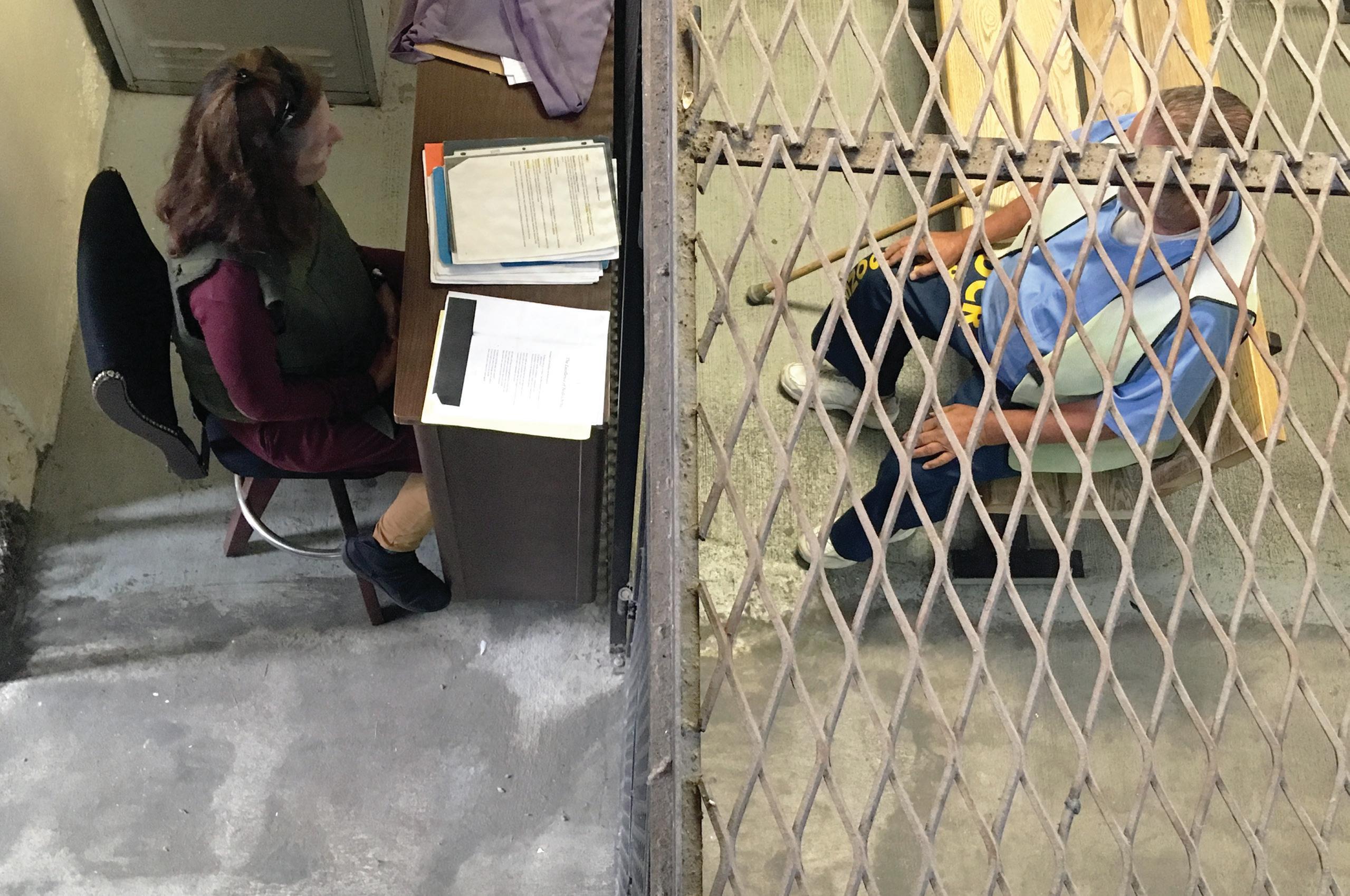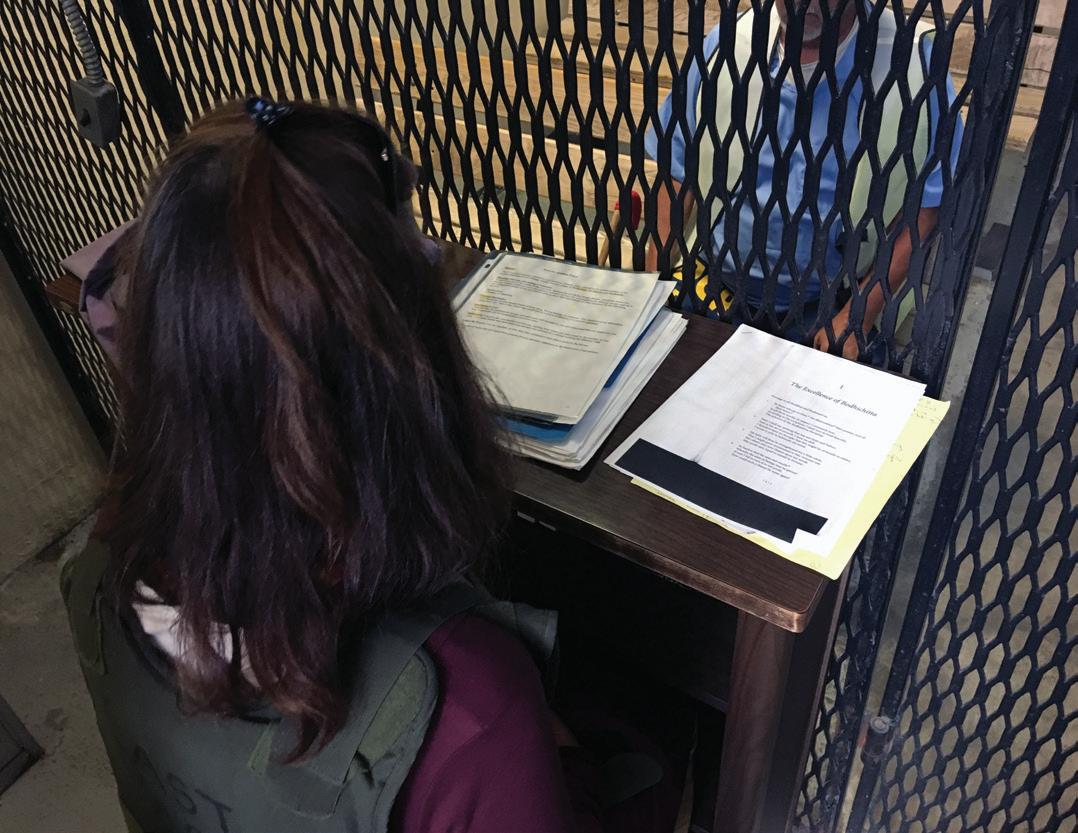
8 minute read
Death Row Buddhism
By Susan Shannon
At 2:30 pm on any given Tuesday, I begin my Buddhist service on San Quentin’s Death Row. As I sit in the makeshift chapel with the men who attend my services, we are separated by a metal screen. As always, the 735 men in the five-tier block are yelling to each other and moving around their cells. A cacophony of voices and movement engulfs us. The thunderous sound nearly drowns my voice as I begin our opening meditation. But then something miraculous happens. Inexplicably, the voices begin to fade—even those of men several tiers away, who are able to hear our mantra. By the time we are finished with our meditation, the noise has entirely ceased. On some days, the block gets so quiet that it almost feels like you can hear the other men breathing along with us.
This kind of magic occurs frequently during my weekly visits to the Death Row chapel—a converted shower about the size of a handball court at the eastern end of the cell block. Around the perimeter above it is a gun rail with an armed guard always present. To the far side is a sally port with stairs uniting both sides of the block. To the front is a small platform about the size of two telephone booths, separating the rest of the “chapel” from where the chaplains and ministers sit. The body of the chapel has three well-worn, thick wooden benches, bolted into the cement floor with black cast-iron hardware. This is where the men sit, facing me. Directly behind me are two shower stalls, still in use, which I must pass in front of to get to my little podium.

I visit with several groups of men who are separated into different yards, depending on their crimes and gang affiliations, amongst other factors. The groups range in size, from three to ten men at a time. Every time we meet, we follow a basic structure of the elements of a Buddhist service. One of these is called Dedication. Dedication plays a huge role in Buddhism, one that can help foster a sense of purpose, and connection to the rest of humanity.
This is especially important to those who feel or really are isolated from others. We discuss how dedicating our actions for the benefit of others can open hearts, and change the way we engage energetically with the rest of the world. In Buddhism, we call this cultivating Bodhicitta, the Awakened Heart. This is the essence of Buddhist practice. As we learn to dedicate all the actions of our body, speech and mind to relieve the suffering of all beings, we go through an almost alchemical change, a softening, and a greater sense of connection and interconnection gives more meaning to everything we do, think or say. Our vibration changes on an inward level, and over time, sometimes immediately, our outer lives begin to change. Whether incarcerated or not, this is the transformative element of Buddhism.
I start each service by leading the men in guided meditations on our intentions. First, we focus on posture and breathing. We take several counted breaths together, then scan our bodies for tension, breathing into those spots with loving awareness. After meditating, we often move on to studying one of many Buddhist texts that teach about cause and effect. We talk about how the intention we put into everything, from turning on the tap to drink and remembering all beings who have no clean drinking water, to watching TV and praying for the suffering beings. One man told me that every time he exercises in his cell, he remembers all his homies, his family, his victims and his friends and says a prayer for their health. When he dresses, even though he only has two shirts, he thinks of all the people in the world without clothing. In this way, we can actively engage with others in everything we do throughout the day.
I call this a journey becoming a Warrior of the Heart. It awakens us to our own Buddha nature, or “Christ Consciousness”— however we want to name it. Transformation is a birthright of all of us, no matter where we live. In Buddhism it is often said that when one has the wish to Awaken, and to live to benefit all beings, no matter what one’s past has held, positive transformation is not only possible but supercharged. This is how intentional dedication changes the men on Death Row, where spiritually there are limitless transformational possibilities.
However, this practice is not always easy on Death Row, where most of the men will never get out to see a tree or animal again, where their contact with the rest of humanity is limited to their attorneys, their loved ones or friends if they are still in contact, or with the yard of men they’ve been assigned. Some of them have been here on what they call “the shelf” for upwards of 30 years. Despite these difficulties—or perhaps because of them—the men are very open to these lessons. Like all of us, they are not defined by the worst moments of their lives. They are hungry, in fact starved, for ways to be of benefit to the world on the outside.
We focus a lot on the Buddhist act of dedication. I use what they have access to in order to work this muscle: By focusing on themselves, their thoughts, their words and actions, they can develop true compassion for the suffering of all species. Even through the simple act of witnessing the suffering of others, we begin to resonate with our own interconnectedness with all beings.

As we move through our practice week after week, change begins to manifest in the men in my class in small ways. One week it might start with one student finding that he no longer wants to flush spiders down the drain. The next, another student might make a new friend. At one Buddhist service, a Death Row student disclosed that after decades of practicing medication and mantra, some major new developments had been revealed in his case, which could lead to a re-sentencing. Not only that, but a handful of old friends and relatives had resurfaced in his life. “I don’t even feel like I am HERE!” he said. “I mean, I know I am here, but not HERE here,” he exclaimed, pointing to the walls around us.
I am proud to say that this practice has brought new life to the men on Death Row, not just through greater connection with the world outside, but also in their relationships on the Row itself. During one particular service, I walked into the little makeshift chapel and found two students were giggling, giddy with excitement. One man had his hands behind his back and the other was leaning into him as if they were hiding something.
I couldn’t help laughing, as they were so obviously up to something. “Hey you guys, you look like two kids at Christmas,” I said to them. “What’s up?”
A few seconds more of shuffling and smiles, and the first student said, “Okay, show her, show her now!” The second student then turned towards me and lifted up something that was so foreign to this dark place that my mind couldn’t grasp it at first.
The second student was holding a little pot made of the bottom of a bleach bottle, decorated with candy wrappers. There were six strong, healthy green plants growing inside. I’d never seen anything green here, except for the guards’ uniforms. There are no plants anywhere here on the Row. In the middle of the little grove sat a crocheted white bunny, as if peacefully grazing in this piece of heaven.
“This is so incredible!” I stammered, when I could speak again. The first student was beaming. “Isn’t it great!” he said. “I think we should bring this every time we meet. It adds something to the space here, don’t you think?”
The second student explained that the plants were Fuji apple seedlings, grown from seeds. He had dug dirt out of the cracks in the cement on the yard and made compost in his cell out of tea bags and leftover vegetables. In this dirt, he planted the trees; new life flourishing in the place where life is meant to be condemned.










